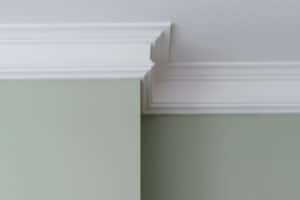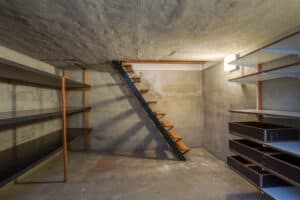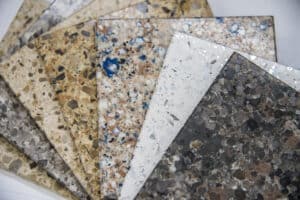
What’s the difference between drywall and plaster?
Some use the terms “drywall” and “plaster” interchangeably.
But there are clear differences between the two.
Here is everything to know about the differences between drywall and plaster (and why it’s important to use the proper term).
Drywall Vs. Plaster (What’s The Difference?)

Drywall is made up of gypsum held together by a piece of paper on each side.
Most drywall comes in 4’ x 8’ sheets.
You may need to cut these sheets down to size for tight spaces.
Plaster is made up of wood with multiple layers of plaster applied on top of it.
You create the material yourself, so it doesn’t come in precut boards.
Instead, plaster comes in a large tub.
This process is more labor-intensive than putting up drywall.
Drywall tends to be the more modern solution for your wall assembly.
However, many pre-WWII homes still have plaster.
Plaster meets all building code requirements for your wall assembly.
If installing a new wall, you can choose either option.
Which Is Better: Drywall Or Plaster?
Most contractors will immediately claim drywall is better than plaster.
It’s much easier to install, and they’re the ones doing the work, after all.
However, both drywall and plaster have distinct advantages and disadvantages over each other.
The largest difference is installation.
Drywall is much easier to install, making it a no-brainer for large projects with tight deadlines.
However, many people like the classic method of applying plaster thanks to its sturdiness.
It’s also considered a high-end option for an added touch of luxury.
Can I Install Drywall Or Plaster By Myself?
Novice DIYers can install drywall successfully with the proper research and attention to detail.
Do not attempt to install plaster unless you already feel comfortable installing drywall.
It requires intermediate or advanced DIY knowledge.
Hire a professional contractor if you want plaster walls or don’t feel comfortable with your DIY skills.
Wall Assembly Anatomy

Before moving forward, it can be beneficial to explain the anatomy of your wall.
Here are the different components your wall assembly from the outside in:
- Exterior Cladding: The visible exterior of your home, also known as your home’s “siding.” It acts as your home’s first defense against the elements and also enhances the appearance of your home. Some of the most popular options include brick, vinyl, aluminum, and wood.
- Exterior Sheathing Membrane: Optional thin waterproofing membrane known as building wrap. Used in areas where high moisture is coming from outside the home.
- Exterior Sheathing: A flat layer of wood that supports the home’s siding.
- Insulation: Material designed to prevent airflow through your wall.
- Structural Components: Support beams usually made from wood designed to hold the weight of the house.
- Vapor Barrier: Optional thin waterproof wrap used for homes where moisture inside the home is a larger concern than outside the home. Homes usually have either an exterior sheathing membrane or a vapor barrier but not both.
- Interior Sheathing: Finished interior wall visible to you inside your home. Usually made from drywall or plaster.
For more information on the different vapor barrier materials, read our article on Tyvek or Tar Paper: Which is Better?
Advantages And Disadvantages Of Drywall And Plaster

When choosing between drywall and plaster, it comes down to what you prioritize.
Are you sticking to a tight budget?
Do you want a noisy room to stay quiet?
We will cover some of the considerations to make when making your decision (and the winner for each category).
1. DIY Installation: Drywall
As we mentioned, drywall is much easier to install than plaster.
To install drywall, you simply screw the boards into the studs of the wall.
To install plaster, you will screw long wooden boards into the studs and then apply layer after layer of plaster on top of the wood.
It takes time for the plaster to dry between each layer.
2. Cost: Drywall
Drywall and plaster cost roughly the same when it comes to the materials.
However, installation for plaster costs about three times as much as drywall installation thanks to how much longer it takes and the specialized knowledge required.
If installing the wall yourself, the cost will be about the same.
However, you will pay more in time if you choose to install your wall using plaster.
3. Attractiveness: Plaster
Plaster provides a smooth, seamless finish.
It’s often used as an upgrade for high-traffic rooms to boost the aesthetic appeal.
It’s also much nicer looking in corners and tight spaces.
Drywall doesn’t bend easily, and you may be able to see the edges between boards.
Some people choose to use drywall in places most people don’t see, such as the attic but use plaster in the kitchen and living room.
Always use a quality primer when painting plaster as many paints won’t stick to the material without the primer.
While you should use a primer with drywall, too, it’s especially important for plaster.
You probably want to avoid “all in one” paints that include a primer and get a designated primer.
4. Sound Insulation: Plaster
Plaster is much denser than drywall, meaning it can absorb sound noticeably better than drywall.
Soundproofing is desirable for playrooms, bathrooms, offices, and media rooms.
5. Strength: Plaster
While you can find strong, thick drywall, plaster tends to be thicker and stronger.
It won’t get damaged as easily as drywall.
You can apply plaster thicker than the standard application by adding another layer.
You can’t get drywall thicker than ⅝”.
Unfortunately, when plaster does become damaged, that durability and uniformity that you love can turn around to bite you.
6. Maintenance: Drywall
When drywall gets damaged, it’s much easier to fix than plaster.
You can simply replace the board if the damage is extensive enough.
To fix small holes, you can actually apply a bit of plaster over the hole.
Minor damage in plaster can be repaired by applying additional plaster to fill in the crack.
When plaster experiences major damage, you will need to repair the entire wall instead of replacing a single board.
It’s much harder to access the inside of a plaster wall compared to a wall made from drywall if you need to install new insulation or a new vapor barrier.
If you have cracks in your wall after proper installation, it can indicate a foundation problem.
Small cracks aren’t a cause for concern, but if the cracks get bigger, you should fix the foundation problem ASAP before it gets worse (and more expensive).
7. Efficiency: Drywall
While not as dense as plaster, drywall is designed with thermal efficiency in mind.
Your home’s efficiency rating indicates how well air can permeate through your walls and impact the air inside your home.
With drywall doesn’t provide sufficient efficiency on its own, it can provide roughly 40% of your wall’s energy consumption capabilities.
The thicker the drywall or plaster, the more effective it will be at blocking outside air.
The majority of your wall’s insulation comes from the insulation.
Insulation has an R-value that indicates its efficiency with higher R-values meaning better efficiency.
You can increase the R-value of your walls by adding a second layer of insulation.
For example, if you use one layer of insulation with an R-16 efficiency rating and add a second layer with an R-13 efficiency rating, you get a total R-value of R-29.
Properly insulated walls lead to less strain on your HVAC system, meaning lower utility bills and a more comfortable home.
When installing a new wall, use the opportunity to enhance your home’s efficiency both for your comfort and to appeal to potential buyers in the future.
How Can I Tell The Difference Between Drywall And Plaster?

Are you looking at your walls wondering if they are made out of drywall or plaster?
You may struggle to tell the difference at first, but once you understand how to distinguish between the two, you’ll never forget.
Here are a couple of ways you can determine if your walls are made from drywall or plaster.
1. Consider The Age Of The Home
While not a guarantee, you can guess the material of your walls based on the age of the house.
Plaster was the standard for homes built before WWII.
Since drywall wasn’t widely used at this time, older homes built before WWII containing the original building materials typically contain plaster.
During WWII, Americans prioritized efficiency and cost-effectiveness.
When drywall was introduced, it was a no-brainer to utilize the cheaper, easier process on a mass scale.
That’s why most newer homes use drywall.
2. Put A Tack Into The Wall
Take a tack and push it into the wall in question.
Did it slide into the wall easily?
You have drywall.
Was it difficult to push the tack into the wall after multiple attempts in different places?
You have plaster.
3. Look Inside Your Wall
Find a way to peek into the inside of your wall either through a light switch hole or from your attic.
Inside your wall, do you see large boards with paper on either end?
You have drywall.
Do you see wood lath boards?
You have plaster.
Tips For Working With Drywall

You’ll learn detailed techniques for how to best handle drywall as you continue to work with it and when to use different techniques.
To start, try these beginner’s tips for working with drywall.
1. Use Correct Tools To Cut Drywall
When working with drywall, you will inevitably need to cut a large board down to a smaller size.
You will also need to cut holes for electrical wiring.
Clean cuts will make a big impact on the final appearance.
Most contractors and DIYers use a utility knife.
However, the edges won’t always come out perfectly clean.
Also, it can be rather labor-intensive if you need to make large cuts.
For the best results, use a drywall saw.
It’s specifically designed to cut through drywall and provides the cleanest results possible.
When you need to install holes for electrical wiring, a circular saw will provide the best results.
2. Enlist Help
Technically, you can install drywall by yourself.
However, the large boards get difficult to work with, especially if you are installing the drywall on the ceiling.
Enlist the assistance of a family member or friend to keep the drywall board securely in place while you screw it in place permanently.
3. Apply Joint Compound For Smooth Finish
To mimic the smooth finish of plaster, you should apply joint compound, or drywall mud, on top of the drywall after it’s installed.
Once you apply a generous amount of the material, use a putty knife to smooth it out over the entire surface at an even consistency.
Allow drywall mud to dry completely before applying primer and paint.
Tips For Working With Plaster

While each job has its unique challenges, try these tips when working with plaster walls.
1. Install Hanging Hardware Into Wall Before You Finish Plastering
Many of us like to adorn our walls with personal artifacts, such as artwork and mirrors.
Plaster can break if you aren’t careful when you nail hanging hardware into it.
Plan ahead and install hanging hardware into your wall before you finish applying the plaster so that it’s part of your wall’s construction.
2. Use A High-Quality Stud Finder
Since plaster is so thick, a low-quality stud finder may not read through the material.
It’s absolutely critical to use the studs when hammering things into a plaster wall, so you can’t simply guess the location of the stud unless you want to risk potentially expensive repairs.
Use a stud finder specifically labeled as having “deep penetrating technology.”
Different Types Of Drywall

If you decide to go with drywall, you still have to make some decisions about the drywall you purchase.
The first decision is how thick you want your drywall to be.
Thicker is better, but it’s more expensive.
For the small upfront investment, you may save money in fewer repairs and better home efficiency.
Most drywall is ½” thick.
We wouldn’t recommend going lower, but you can find drywall with thicknesses of ¼” and ⅜”.
The thickest drywall you can find is ⅝”.
Most people use standard drywall, but you can find drywall designed to accommodate special conditions.
You can find moisture-resistant drywall, mold-resistant drywall, and fire-resistant drywall.
Mold-resistant and moisture-resistant drywall have one paperless end that has an additional coating that repels moisture.
Fire-resistant drywall is usually ⅝” thick and also contains glass fibers that don’t burn easily or spread heat/flames.
Different Types Of Plaster

Here are three different types of plaster to be aware of when you go to the hardware store.
1. Waterproof Plaster
Made from a mixture of cement and sand, waterproof plaster also incorporates pulverized aluminum (12 kilograms per cubic meter of sand) and soft soap (75 grams per liter), which creates a chemical reaction that creates a tight seal around the pores.
Ideal for homes with high levels of interior humidity.
Waterproof plaster should work in conjunction with the wall’s vapor barrier and not replace it.
2. Lime Plaster
Lime plaster consists of equal parts lime and sand, making it eco-friendly.
It’s the most flexible plaster option, making it the best for maintenance.
Best for preventing cracks from becoming noticeable.
3. Stucco Plaster
Attractive stucco plaster consists of three layers:
- Scratch coat (deepest layer): 10 mm thick of 1 part cement to 3 parts sand and 10% lime
- Brown coat (middle layer): 10 mm thick of 1 part cement to 2 parts sand mortar (no lime)
- White coat (top layer): 4 to 6 mm thick of white or colored decorative cement
Stucco plaster is generally considered the most attractive option.
However, it’s not malleable after it’s installed and not as eco-friendly as lime plaster.
It’s also not as waterproof as waterproof plaster.
Conclusion
The real estate industry considers plaster a high-end option, making it appropriate when building luxury structures.
However, when choosing between drywall and plaster, thick drywall with proper drywall mud application and a high-end paint job is the better option.
Plastering takes three times as long to install, but it doesn’t create three times better results.
Your contractor will thank you.
If you are installing the wall yourself, especially as a beginner, drywall is the only logical option.



Good explanation, lost plaster walls torn down, when I went to hospital — to gypsum— by a friend fixated watching HGTV (slum ideas),no finnese!